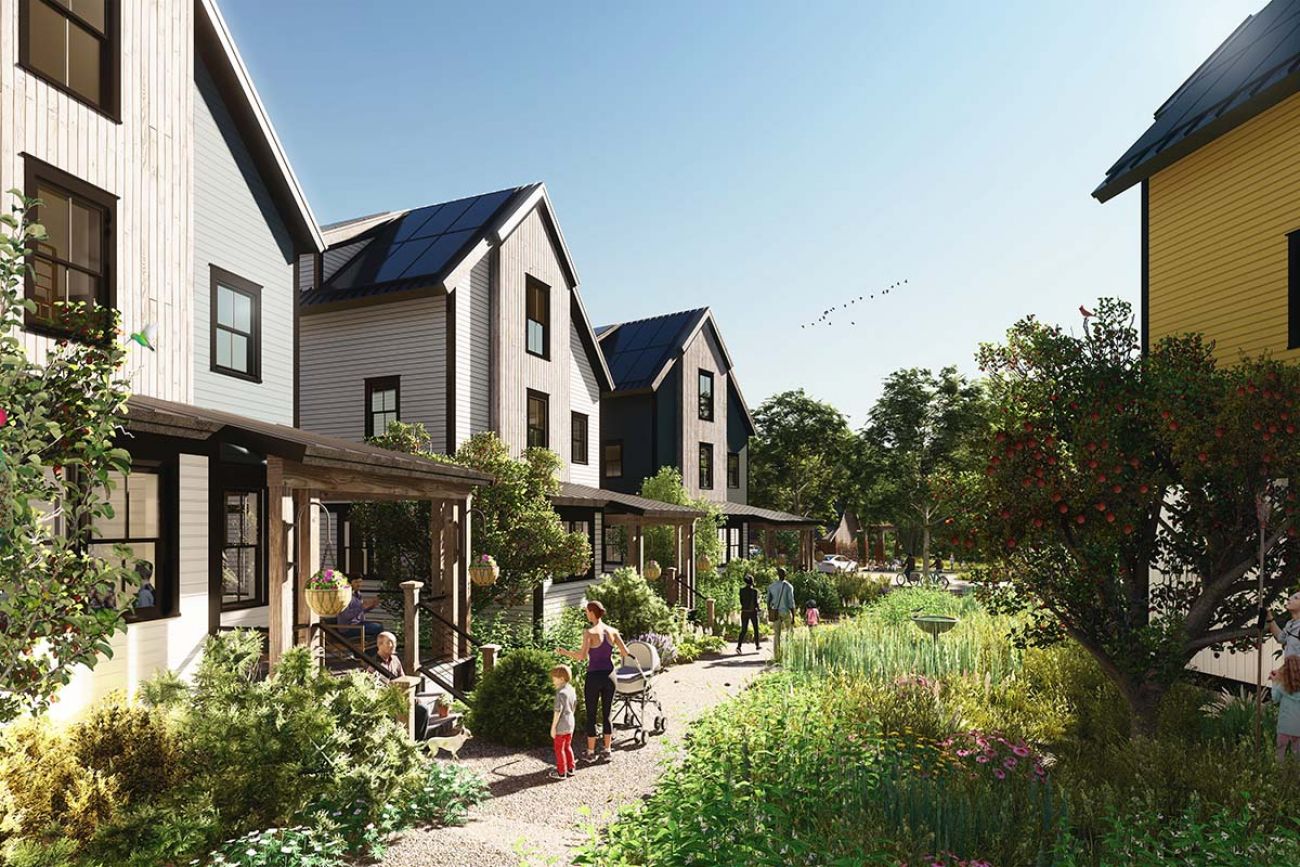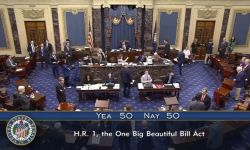Ann Arbor pours money into green affordable housing. Will others follow?

Five years ago, developers and government officials in Ann Arbor launched a project to bring eco-friendly construction to the masses. It was a novel concept and very on brand for the progressive, affluent college town.
The idea was to have local government subsidize some up-front costs of green housing and reserve some units for lower-income residents; people who could never afford the solar panels, geothermal heat pumps and other expenses that ultimately lower energy bills while burning less fossil fuel. Luxury homeowners would live alongside families of modest income and people transitioning from homelessness, adjacent to 130 acres of wooded land.
In the years since, climate-friendly affordable housing development has become all-but-routine in Ann Arbor.
Related:
- Duck and goose populations booming in Michigan. Other birds? Not so much.
- Activists push Michigan for bolder, faster climate efforts
- Updating Michigan energy rules on new homes faces pushback from builders
But a larger question remains: As more homeowners (and developers) recognize the need to eliminate fossil fuels that contribute to climate change, are projects like those adopted in places like Ann Arbor scalable to less resource-rich communities?
“It’s possible,” said Matthew Grocoff, whose Thrive Collaborative is co-developing the Ann Arbor project, called Veridian, with nonprofit Avalon Housing. But he and others said it requires an aligned vision among officials, developers and communities to pull it off.
“You need a different methodology of construction,” Grocoff said. “You need cooperation from the local authorities, from the planning commission, and you need to really push to make it happen.”
Ann Arbor, sustainability city
Because residential housing represents 21 percent of U.S. energy consumption, it is a focal point of efforts to decarbonize the economy — something experts say the world must do by 2050 to avoid the worst effects of climate change.
Affordable housing, often known for using cheaper material and cutting corners on insulation, has been a key target in climate-conscious Ann Arbor, said Jennifer Hall, executive director of the city housing commission.
In 2014, the city became one of the nation’s first to publish a local climate action plan, and has since opened a sustainability office with staff and a budget to implement the plan. Voters have been quick to tax themselves to support both affordable housing and climate action.
Beyond the Veridian neighborhood, Ann Arbor has already completed several eco-conscious affordable housing developments, and city officials just announced plans for another 68 units of super-efficient, solar powered housing in the city’s downtown. They’ve instructed firms vying to develop yet another planned project to aim for a net zero-emissions — which means the home produces as much or more energy than it consumes.
Veridian’s developers plan to break ground this spring, with the first residents moving in as early as mid-2023. Thirty units will be reserved for people who would otherwise be chronically homeless, and another 20 for those making less than 60 percent of area median income (which amounts to $63,900 or less for a family of four). They’ll live alongside homeowners who will pay between $185,000 and $940,000 for one of 110 market-rate units.
Grocoff said the development team knew if their concept could work anywhere, it could work in Ann Arbor – a community with high incomes, a green ethos, and a constituency willing to part with some of the former in pursuit of the latter.
Public support has been crucial to making Veridian’s $12.8 million affordable housing development possible, said Wendy Carty-Saxon, director of real estate development at Avalon, the nonprofit developer of the neighborhood’s affordable housing.
Washtenaw County commissioners had been considering a range of ideas to redevelop the site, which had housed a juvenile detention center. They rejected higher bids in favor of Veridian, and donated 4.7 acres for the neighborhood’s affordable units.

The city of Ann Arbor, meanwhile, supported the project with more than $1 million from an affordable housing tax voters approved in 2020 — money Hall said will help bridge Veridian’s higher building costs compared to traditional affordable housing projects.
Hall acknowledged that’s a resource many communities don’t have — one that can mean the difference between pursuing eco-friendly housing that includes more expensive building materials and solar panels, and standard builds that cost less to design and build, but generally end up costing more in the long run on energy expenses.
“If you don't have the cash, you don't have cash,” she said of the initial costs. “So it makes it hard for some communities.”
Barriers remain
While the economic case for climate-friendly housing has strengthened in recent years as homeowners recognize the longer-term savings, local officials and national experts told Bridge that projects like Veridian remain a tough sell for many communities.
“If you don't have somebody in your community, whether it's administration or council, or staff or the community itself pushing for it,” Hall said, “it's just not going to happen.”
Green building projects require more planning and design work, making them difficult for smaller or poorer communities operating with fewer staff and less money.
And while Avalon is both developer and landlord at its projects, many developers don’t pay the utility bills at the properties they build, said Carty-Saxon, Avalon’s real estate development chief, leaving them with few incentives to invest in energy-efficiency.
Policy changes can help shift the debate. Carty-Saxon noted that affordable housing developers competing for limited public funding often score higher if they can keep construction costs down — a system that can dissuade green development.
Even with local subsidies and help navigating policy, getting to net zero is not yet guaranteed for the affordable housing portion of the Veridian development. Grocoff said that’s partly because of state-level policy barriers that limit the ways multi-family housing developments can use solar. But Carty-Saxon said building costs are a barrier, too.
For now, buildings at Veridian are being designed “solar-ready,” with all-electric appliances and no gas hookups. The plan, Carty-Saxon said, is to incorporate solar panels “when and if it’s available.”
A shift ahead?
Such barriers mean that, for now, projects like Veridian will likely remain confined to “progressive communities that tend to have climate offices,” said Amber Wood, director of the American Council for an Energy Efficient Economy’s buildings program.
Think Ann Arbor, Grand Rapids, Traverse City.
But the logistical and cost barriers that discourage green development elsewhere are rapidly shrinking.
A 2019 analysis by the Rocky Mountain Institute found that zero-energy homes cost an average of 6 to 8 percent more than the average new home, but extra costs can be offset in the form of long-term energy savings, and the cost difference is diminishing over time.
Political and philosophical resistance to climate action is also diminishing, said Jennifer Rigterink, a legislative associate with the Michigan Municipal League, an advocacy group for local governments.
One example: The Michigan Green Communities Network, a group of local governments focused on sustainability, now includes larger, wealthier, liberal places like Ann Arbor as well as smaller places like Ithaca, less-affluent places like Flint, or more conservative places like Hartland Township.
“More and more communities are getting more comfortable talking about it,” Rigterink said.
Some housing agencies are also encouraging green development.
The Michigan State Housing and Development Authority, for instance, now rewards green innovation when ranking requests for tax credits to build affordable housing – a shift that has helped green projects compete against lower-cost conventional developments.
“We believe that providing these scoring incentives will promote greener and healthier affordable housing throughout the state,” said Chad Benson, director of rental development for the state housing authority, in an emailed statement.
Other state and federal efforts are also building the case. The Michigan Public Service Coalition, for instance, has a workgroup dedicated to reducing energy waste, and an ongoing effort to revise Michigan’s building codes could make some energy-efficient features standard in all new construction.
At the federal level, the Biden administration has vowed to invest in energy-efficient affordable housing. The latest version of the Build Back Better bill includes $150 billion-worth of affordable housing provisions, though details remain scarce and it’s far from clear the bill will pass.
But Rigterink, of the Municipal League, said widespread adoption of green affordable housing will take more than incentives.
“To truly see some change,” she said, “it’s got to be a requirement.”
So far, the suggestion of strengthening climate-focused building requirements has prompted pushback. Two Republican Michigan lawmakers, for example, are pushing bills that would block local governments from banning natural gas hookups in new construction.
Grocoff, the Veridian developer, remains optimistic. He said projects like Veridian and Ann Arbor’s other sustainable affordable housing efforts represent an effort to “prove what’s possible.”
“The real challenge,” he said, “is making it possible everywhere.”
Editor's note:
Michigan Environment Watch
Michigan Environment Watch examines how public policy, industry, and other factors interact with the state’s trove of natural resources.
- See full coverage
- Subscribe
- Share tips and questions with Bridge environment reporter Kelly House
Michigan Environment Watch is made possible by generous financial support from:
Our generous Environment Watch underwriters encourage Bridge Michigan readers to also support civic journalism by becoming Bridge members. Please consider joining today.
See what new members are saying about why they donated to Bridge Michigan:
- “In order for this information to be accurate and unbiased it must be underwritten by its readers, not by special interests.” - Larry S.
- “Not many other media sources report on the topics Bridge does.” - Susan B.
- “Your journalism is outstanding and rare these days.” - Mark S.
If you want to ensure the future of nonpartisan, nonprofit Michigan journalism, please become a member today. You, too, will be asked why you donated and maybe we'll feature your quote next time!






